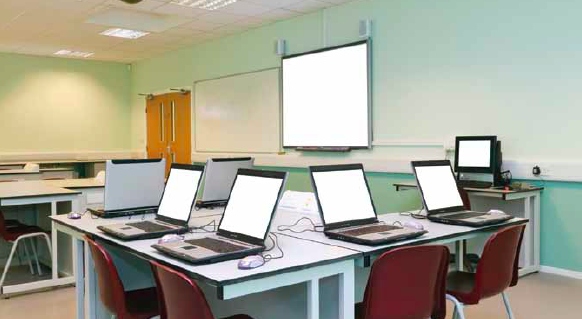
What is technology-rich innovation?
Considerations for educational leaders who are initiating and maintaining change in the 21st century

| Key ideas How do we look at change in education today? What is considered excellent technology use? |
| School-based innovation How do learning technologies yesterday and today differ? How are these altering school-based innovation? |
| The knowledge economy In modern society witnessing a revolution? Are traditional educational methods disappearing? Should they? |
| Themes and trends What European initiatives are currently promoting teacher competence in ICT use? |
Key ideas about change in education today
| Learners central All learning proceeds from the motivation of the learner, either in the context of curiosity about the external world or in the desire to acquire a valued skill |
|
Three levels of excellence in teaching according to the UNESCO ICT Framework |
|||||||
| Education ≠ schooling Education, as both process and outcome, is now seen as very different from schooling in structure and intent |
|||||||||
| Knowledge creation Knowledge creation is the ultimate goal in technology-rich innovation |
|||||||||
| Rapid changes The pace of learning and knowledge creation today is often portrayed as possibly the most rapid in human history |
|||||||||
| New priorities Education is now shaped by critical factors that include: openness, adaptability, accessibility, innovation and learner-centric |
School-based innovation: Learning technologies yesterday and today
| All learning proceeds from the motivation of the learner, either in the context of curiosity about the external world or in the desire to acquire a valued skill. Educational methods and techniques have, however, historically developed in response not only to learners’ needs, but also to the needs of wider social, political and economic structures. Today’s advanced technologies environment is in many ways an issue as old as education itself. It is the link between what individuals need to know, do and learn at a time of profound change. | |||
At their most basic, learning technologies focus on the tools, methods, techniques and operational modalities that envelop the learning and didactic process. Over the past few decades, a complete revolution has occurred regarding not only our approach to the understanding of educational theories, but also our ability to use new and innovative methods to design and deliver learning. This process has promoted a significant re-evaluation of the role and purpose of education and the most appropriate delivery methodologies to ensure optimum learner engagement. Education, as both process and outcome, is now seen as very different from schooling in structure and intent. This point was originally articulated by Ivan Illich in the 1970s (De-schooling Society). Today, learning technologies permit the acquisition of knowledge, skills and attitudes in many new and innovative ways. |
|
||
In all teaching contexts, learning technologies are important. The emergence of standardized methods of instruction took on a radically new dimension during the Industrial Revolution. This marked growing synchronization of teaching methodologies with requirements for improved work performance and productivity. The knowledge explosion and information revolution of our own era is still deeply marked by the experiences, structures and expectations of the industrialization process. Knowledge acquisition is central to the ODS endeavour as well as its underlying model of innovation and reform. Knowledge creation is the core of a set of skills, values and attitudes that, in their structure and imparting to others, are the essence of culture. The pace of learning and knowledge creation today is often portrayed as possibly the most rapid in human history. The mode of production and the distribution of knowledge have changed so radically that it is considered legitimate to speak of a new era. This is described as the information society. In this new paradigm, we see more production, distribution and use of knowledge than before. The knowledge economy Themes and trends Across Europe, many initiatives promote teacher competence and information and communications technology (ICT) usage. A few examples include: Key Competences for Lifelong Learning (2007); Strategic Framework for Education and Training 2020 (2013); and the Digital Agenda for Europe (2010). The Key Competences document defines digital competence for all citizens, and identifies relevant knowledge, skills and attitudes to live and work in the 21st century. Inclusion of Digital Literacy as one of eight key competences indicates the importance attributed to ICT skills at European level. Combining ICT skills with emerging views in pedagogy, curriculum and school organization, the Standards reinforce professional development of teachers who use ICT skills and resources to improve their teaching, collaborate with colleagues and ultimately become innovation leaders themselves. As shown above, the UNESCO ICT Framework has three different levels of excellence in teaching: technology literacy; knowledge deepening; knowledge creation. The Open Discovery Space (ODS) approach is designed to recognize the profile of registered teachers and use it as an additional element to decide most appropriate learning objects. Instructional environments in some classrooms (including activities around preparation for paper-based state examinations) may not easily lend themselves to the development of and usage of e-learning environments. The local contextualization of innovations is therefore a critical concern that affects the uptake and use of new ideas. Various initiatives across Europe support tailoring and customization to specific settings.
For example, the Irish NCTE handbook - Planning and Implementing e-Learning in Your School: A Handbook for Principals and ICT Co-ordinating Teachers - recognises the important role of school leaders in promoting ICT in teaching and learning at school level. It provides a definition of e-learning, and outlines how schools can develop under five headings: leadership and planning, ICT in the curriculum, professional development, e-learning culture and ICT infrastructure. The handbook includes an e-Learning Roadmap which helps schools to plot their development reflected on a four-point rating scale of e-maturity: Initial; e-Enabled; e-Confident; e-Mature. The Irish roadmap facilitates planning and goal setting and targets at an individual school level. Research has also consistently demonstrated that computer-based interventions and open education resources tend to be more effective when combined with constructivist approaches to teaching, rather than with more traditional approaches. Having identified trends and issues, the innovation model is challenging. However much has been achieved already. The obstacles and opportunities have been identified. ICT in schools requires both leadership and vision. This helps it to move beyond a simply perceived technical skill to recognition of its critical role in shaping competence and learning innovation at a time of profound transformative and globalized change. The ODS model offers one clear, yet flexible vision for technology-rich innovation that can be tailored to meet the needs of specific learners, in particular schools, in varied contexts across Europe. |
|||


